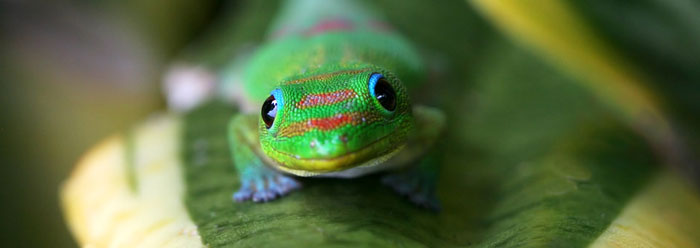Certain gecko lizards can see color in dim light. That means these geckos’ eyes are about 350 times more sensitive than human eyes, which see only black and white in the same conditions. Can evolution account for the origin of the remarkable machinery that enables these nocturnal creatures to see so well?
Scientists studying the helmet gecko’s eyes found distinct concentric zones, each with a different refractive power. Geckos also have a much higher density of oversized cone cells in their retinas that are responsible for detecting specific light wavelengths. In their study published in the Journal of Vision, the researchers found that together, these zones and cones form a “multifocal optical system.” Furthermore, the refractive powers of their lens array “is of the same magnitude as needed to focus light of the wavelength range to which gecko photoreceptors are most sensitive.”1 Thus, the various parts of this gecko’s eyes are finely tuned to work together, allowing the animal to sharply focus on at least two different depth fields at the same time.
In addition to seeing color in the dark, the geckos have built-in correctional abilities for blurred images caused by longitudinal chromatic aberration, or the failure to focus all colors to the same point. Studying these features in gecko eyes may offer clues to improving camera technology.2
The authors of the study asserted that “at some point in evolution a group of lizards, the geckos, turned to a nocturnal lifestyle. In response to the demands of nocturnal vision without rods, the cones of nocturnal geckos have become much larger and more light–sensitive than those of their diurnal relatives.”1 However, there is no evidence that the mere presence of an environmental demand can cause the coordinated physiological changes required to bridge the differences between monofocal eyes and this gecko’s multifocal, supersensitive eyes. Nor is there any evidence that mutations can do anything but corrupt existing genetic information, the opposite process to what is needed to invent the required whole sets of genetic material that specify the various interdependent parts that comprise these eyes.
Also, many creatures are successful night hunters without color vision. This indicates that the nighttime environment alone is an insufficient cause for developing these particular gecko eyes, which apparently did not “need” to exist for survival. Indeed, other nocturnal geckos have monofocal eyes like humans, and they have survived quite well without major changes.3
There is strong evidence that evolution by mutations could not possibly build these amazing eyes.4 A more feasible explanation involves the creative power and genius of God, who on day six of the creation week implemented all of the design requirements for nocturnal helmet geckos with their specialized visual system.
References
- Roth, L. S. V. et al. 2009. The pupils and optical systems of gecko eyes. Journal of Vision. 9 (3): 27, 1-11.
- “Gecko Vision”: Key to the Multifocal Contact Lens of the Future? The Association for Research in Vision and Ophthalmology press release, May 11, 2009.
- Thomas, B. Fossilized Gecko Fits Creation Model. ICR News. Posted on icr.org September 8, 2008, accessed May 8, 2009.
- Sanford, J. et al. 2008. Mendel’s Accountant: A New Population Genetics Simulation Tool for Studying Mutation and Natural Selection. Proceedings of the Sixth International Conference on Creationism. Pittsburgh, PA: Creation Science Fellowship, and Dallas, TX: Institute for Creation Research, 87-98.
* Mr. Thomas is Science Writer at the Institute for Creation Research.
Article posted on May 29, 2009.




